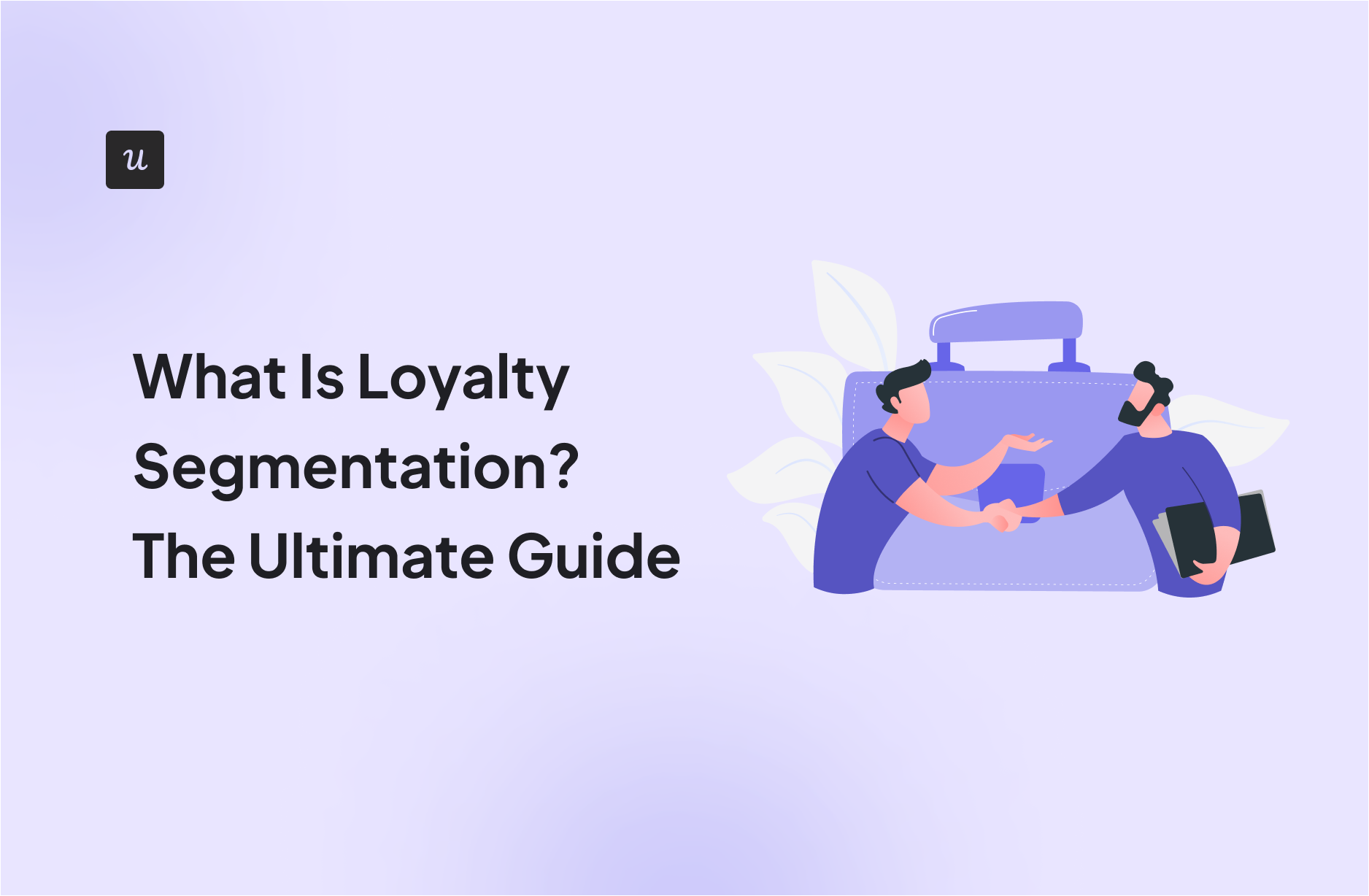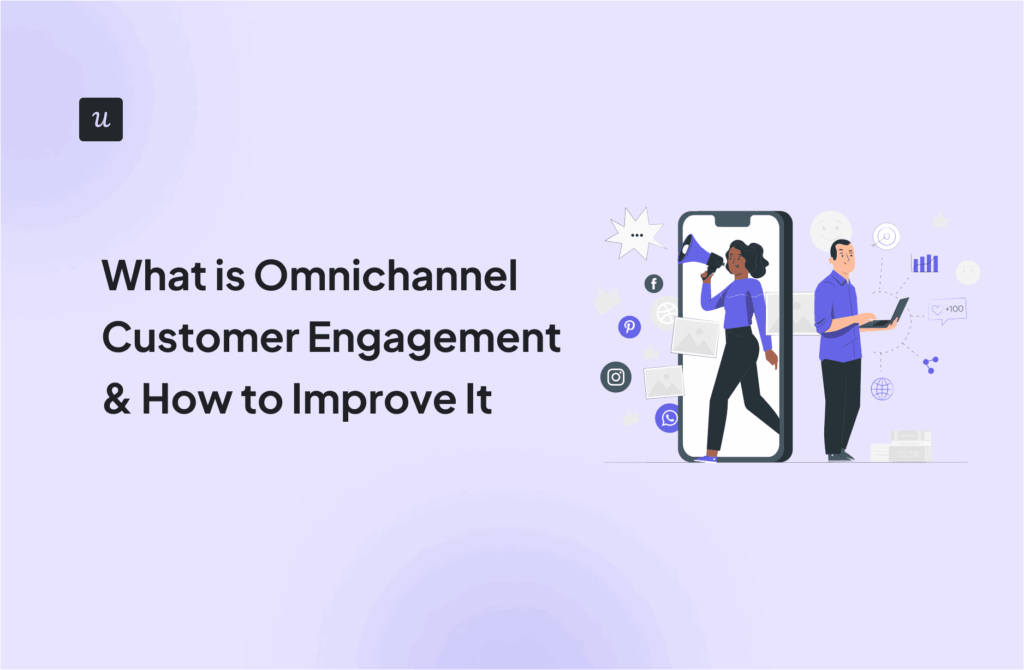
Loyalty segmentation helps you to tailor products, support, and marketing efforts by categorizing customers based on their loyalty levels.
In other words, it lets you recognize and address each customer’s unique needs, making them feel valued and appreciated.
Want to learn how to design an effective loyalty segmentation strategy and boost customer retention? Let’s get started!
Get The Insights!
The fastest way to learn about Product Growth, Management & Trends.
Loyalty segmentation guide overview
- Customer loyalty is a measure of how committed customers are to your product or service.
- Loyalty segmentation is the process of dividing customers into distinct groups based on their loyalty and engagement levels.
- The goal of loyalty segmentation is to boost customer lifetime value by retaining high-value customers for longer.
- Benefits of customer loyalty segmentation include greater retention, improved customer experience, and increased profitability.
- Some common methods of loyalty segmentation include RFM segmentation, customer lifecycle segmentation, and behavioral segmentation.
- There are several important steps you need to take to design a successful loyalty-based segmentation strategy. You’ll need to set clear goals, collect and analyze your data, create customer segments, design personalized engagement strategies, and analyze and optimize.
- While loyalty segmentation offers numerous advantages, it also poses some challenges. For example, you’ll need a robust tool to handle data privacy concerns and collect data efficiently. Plus, it requires constant analysis and feedback collection to remain relevant.
- Find the right tool to make customer loyalty segmentation easier. Book a Userpilot demo today and see how it can help!
What is customer loyalty?
Customer loyalty is the degree of preference a customer has towards your products or services. This loyalty translates into repeat purchases, subscription renewals, and brand advocacy.
Tracking and improving customer loyalty helps increase customer retention and revenue growth.
Several factors can drive customer loyalty, including:
- Product value.
- Customer support.
- Feature updates.
- Loyalty programs.
- The overall user experience.
One such factor is customer segmentation, which enables you to personalize your offerings to fulfill segment-specific needs and enhance customer satisfaction.

What is loyalty segmentation?
Loyalty segmentation is a segmentation method where customers are grouped based on their loyalty behaviors. These customer segments are created by analyzing customer data, taking several aspects into account, such as:
- Purchase behavior.
- Level of activity.
- Customer feedback.
- Advocacy.
Customers nowadays have a diverse range of preferences and are no longer satisfied with a one-size-fits-all loyalty program.
That’s why loyalty customer segmentation is crucial, as it lets you personalize initiatives based on customer interests.
By doing so, you can increase your monthly active users (MAU), gain more high-value customers, and, inevitably, maximize customer lifetime value (LTV).

The benefits of loyalty segmentation
Next, let’s look at some benefits of implementing a loyalty segmentation strategy. It lets you:
- Power customer retention efforts: Since loyalty-based customer segments enable personalization, they are more likely to enhance customer satisfaction and prevent churn.
- Improve customer experience and engagement: Customers engage more with content and loyalty programs specifically designed for them, which is exactly what loyalty segmentation does.
- Boost the value of high-value active users: Loyalty segmentation provides high-value customers with exclusive rewards to increase their average transaction value, which helps boost customer value and drive profitability.

Methods of loyalty segmentation
There are multiple ways to implement customer loyalty segmentation.
The most common types include customer lifecycle, behavioral, hybrid, and RFM. Let’s learn about all these methods of loyalty analytics in detail below.
RFM segmentation
RFM segmentation analyzes customers based on three dimensions – recency, frequency, and monetary value. The RFM analysis lets you identify 4 main loyalty-based customer segments:
- Loyal customers.
- Valuable customers.
- Active customers.
- At-risk customers.
Then, based on this customer segmentation, you can easily customize support and marketing efforts to engage each segment according to their needs.
Customer lifecycle segmentation
Customer lifecycle segmentation divides customers into segments based on which stage of the lifecycle they are in – for example, awareness, acquisition, conversion, or retention.
This customer segmentation strategy ends with the following 6 segments:
- Prospects.
- Free trials.
- Paying.
- Retained.
- Loyal.
- Churned.
For each segment, you can then design a unique loyalty program and targeted marketing campaigns to enhance engagement based on their specific requirements.

Behavioral segmentation
Behavioral segmentation groups customers based on the behavioral data collected throughout their interactions with your product or service.
To create customer behavior-based segments, you need to analyze several elements, such as purchase patterns, product usage, and adoption rates. All this data is then used to create behavioral personas.
By such behavior tracking, you can unlock several insights, like learning about customers’ jobs-to-be-done (JTBD).
Using this information, you can then personalize onboarding and improve your marketing materials for that behavioral segment.

Hybrid segmentation
Hybrid customer segmentation is a combination of different approaches, typically based on a mix of demographics, behavior, psychographics, and loyalty levels.
The benefit of such segmentation is that it creates a more comprehensive customer segment, allowing for greater personalization and improved customer experiences.
How to implement loyalty segmentation in 7 steps
There are steps you need to focus on before you can even start segmenting, like defining your goals and collecting customer data. Let’s go over all key 7 steps in greater detail below.
1. Identify your goals
Clearly defining goals helps provide direction and focus your efforts.
For instance, your goal could be to improve product adoption. Having it outlined lets you allocate resources and track progress more efficiently.
A good rule of thumb is to use the SMART (Specific, Measurable, Achievable, Relevant, and Time-Bound) goal-setting framework.
Here’s a SMART goal example related to loyalty and retention: To increase customer retention by 7% within the next 5 months by implementing a tiered loyalty program that rewards repeat purchases.

2. Collect customer data
Before segmentation, you need to learn more about your customers by collecting relevant data.
This data could include customer interactions and behavior patterns, use cases, psychographic information, etc.
To start data collection, some methods you can use include surveys, tracking in-app customer behavior, analyzing feature usage, etc.

For example, use welcome surveys to collect data at the start to learn customer preferences in real time.
Then leverage this survey data to personalize onboarding for each customer’s specific use case.

Examine what type of customers engage with specific features the most by tracking customer behavior.
For example, a common behavioral-based segment is power users, which includes customers who engage with advanced functionalities and enjoy trying new features.
3. Segment customers based on their loyalty level
Once you have the relevant data from analytics and surveys ready, you can start segmenting users.

For segmentation based on customer loyalty levels, there are several variables you might want to take into account. These include:
- Demographics – age, education, income.
- Purchase behavior – recency, frequency, value.
- Psychographics – lifestyle, attitudes, hobbies.
- Interactions – in-app, website visits, support tickets.
Some examples of common segments include disengaged users, loyal customers, power users, potential loyalists, and customers at risk of churn.

Collecting and analyzing data manually is a laborious task, one that wastes a ton of productive time.
That’s why it’s best to use tools like Userpilot for automated data collection. This will help you easily monitor behavior, perform various analyses, and seamlessly segment customers.
4. Create personalized strategies to engage each segment
With your segments defined, you now need to go back to your goals and list your action plan.
Let’s say your goal was to reduce churn. Your strategy for the “at-risk” segment could include special discounts or better support by offering on-demand webinars.
However, if your goal is to retain active users and upsell, you need different actions. For example, a loyalty rewards program for better engagement coupled with usage analytics to discover expansion opportunities.
Overall, it’s a good idea to create personalized workflows for each segment. Let’s look at some examples of personalized strategies below.
- Enhanced user onboarding: Personalize onboarding by showing customized content that matches the customer’s interests. Include onboarding tooltips for feature discovery to boost adoption.

- Personalized communications: Provide contextual help when needed by using in-app messages. For example, segment customers using welcome screens.

- Use checklists to drive activation points: Checklists provide users with clearly defined steps that reduce time to value, thereby guiding them toward activation sooner rather than later.

- Personalized offers and recommendations: Based on the customer’s usage and behavior flow, you can tailor recommendations, suggesting relevant features to aid adoption.

- Product education and adoption: Create a custom resource center with various content formats to cater to all segments. For example, include product tours, blogs, FAQs, video tutorials, etc.

- Improve product stickiness with interactive walkthroughs: Engage users with hands-on guidance so they can unlock value effectively, thereby reducing their learning curve and driving stickiness.

5. Measure the impact of your strategies
Next, you also have to analyze how your strategies are performing towards goal achievement and impacting KPIs.
This includes regularly monitoring product analytics metrics to measure progress and visualizing data using analytics dashboards to draw valuable insights. Sounds like loads of work, right?
The smart solution is adopting analytics software, like Userpilot. Such tools provide you with customizable dashboards and automated product analytics without any of the complexity.

6. Collect feedback at every step
Gathering real-time customer feedback isn’t just important for its use in analytics. Instead, it’s crucial to continuously collect direct customer feedback as a means of improving loyalty and trust.
Here are some examples of how to collect feedback at each step:
- Automated surveys: Set up surveys after specific interactions, like a customer satisfaction score (CSAT) survey triggered after chatting with the support team.
- User interviews: Feedback doesn’t have to be via surveys. Instead, set up in-depth discussions so customers can express themselves more freely.
- Passive customer feedback: Monitor social media comments, product reviews, and mentions on relevant forums.

7. Run tests, optimize and iterate
Once your customer loyalty segmentation strategy is out there, your job isn’t done.
You need to constantly test, iterate, and improve. So run experiments and utilize A/B testing tools to see what performs better.
The goal is to keep learning so you can optimize the user experience and drive customer loyalty.

Key challenges in loyalty segmentation
- Data privacy: The user data collected for segmentation must be managed in compliance with privacy regulations. Overcome this issue by implementing strict data security measures and anonymizing data where possible.
- Dynamic behavior: Customer behavior changes all the time, so segments need to adapt accordingly. Stay on top of this by introducing feedback loops to record real-time changes in behavior.
- Complex data handling: Loyalty segmentation introduces a more manual and data-heavy workload. This may decrease productivity while increasing errors. Avoid this issue by adopting smart tools like Userpilot to automate analytics and data collection.

Conclusion
Loyalty segmentation is a valuable tool for improving the customer experience and increasing lifetime value.
To create an effective customer segmentation strategy, you must keep certain best practices in mind. These include setting SMART goals, collecting and analyzing data, and continuously experimenting and iterating.
Want to get started with loyalty segmentation? Get a Userpilot Demo and see how you can boost customer retention in no time.






